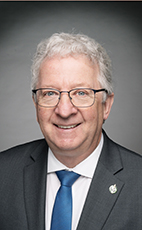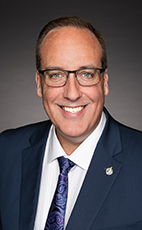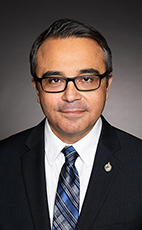44th Parl. 1st Sess.
May 30, 2022 11:00AM
- May/30/22 11:42:41 p.m.
- Watch
Mr. Chair, how did the minister's department arrive at the figures of $647 million, plus $98.9 million for amortization, for the PSSI?
24 words
- Hear!
- Rabble!
- add
- star_border
- share
- May/30/22 11:42:55 p.m.
- Watch
Mr. Chair, the PSSI is historically funded for five years at $640 million, so that is this year's component of the total program.
24 words
- Hear!
- Rabble!
- add
- star_border
- share
- May/30/22 11:43:10 p.m.
- Watch
Mr. Chair, it sounds like a pile of money poured out without a plan.
What evidence does the minister have that the resources and initiatives of the PSSI will increase the recovery potential for Pacific salmon stocks?
37 words
- Hear!
- Rabble!
- add
- star_border
- share
- May/30/22 11:43:24 p.m.
- Watch
Mr. Chair, that is absolutely our intention, and we will be collaborating with the indigenous communities, with harvesters and with others to do just that.
25 words
- Hear!
- Rabble!
- add
- star_border
- share
- May/30/22 11:43:38 p.m.
- Watch
Mr. Chair, that is 300 jobs but no evidence that there is going to be any improvement for Pacific salmon stocks. If the minister is unable to provide evidence of increased potential of recovery, how did she arrive at the figure of $647 million?
44 words
All Topics
- Hear!
- Rabble!
- add
- star_border
- share
- May/30/22 11:43:52 p.m.
- Watch
Mr. Chair, that was allocated before I was appointed as minister. However, I will say that the pillar that has to do with collaboration is extremely important in getting results, because otherwise the province, the federal government and others are working in silos. This—
45 words
All Topics
- Hear!
- Rabble!
- add
- star_border
- share
- May/30/22 11:44:10 p.m.
- Watch
3 words
- Hear!
- Rabble!
- add
- star_border
- share
- May/30/22 11:44:12 p.m.
- Watch
Mr. Chair, for the current fiscal year, what is DFO's budget for aquatic invasive species prevention activities?
18 words
- Hear!
- Rabble!
- add
- star_border
- share
- May/30/22 11:44:23 p.m.
- Watch
Mr. Chair, it is approximately $10 million.
7 words
- Hear!
- Rabble!
- add
- star_border
- share
- May/30/22 11:44:27 p.m.
- Watch
Mr. Chair, what percentage of funding for prevention of AIS is allocated to waters west of the Great Lakes?
19 words
- Hear!
- Rabble!
- add
- star_border
- share
- May/30/22 11:44:37 p.m.
- Watch
Mr. Chair, I would say that it would be less than 50%.
12 words
- Hear!
- Rabble!
- add
- star_border
- share
- May/30/22 11:44:43 p.m.
- Watch
Mr. Chair, why is there such inequity between the amount of funding for the Great Lakes region and western Canada?
20 words
- Hear!
- Rabble!
- add
- star_border
- share
- May/30/22 11:44:52 p.m.
- Watch
Mr. Chair, it is an opportunity to point out the incredible importance of reducing the invasive species growth across the country.
21 words
- Hear!
- Rabble!
- add
- star_border
- share
- May/30/22 11:45:09 p.m.
- Watch
Mr. Chair, who is the final decision-maker as to what science DFO will undertake?
15 words
- Hear!
- Rabble!
- add
- star_border
- share
- May/30/22 11:45:22 p.m.
- Watch
Mr. Chair, the bottom line is I sign off on the department's budget.
14 words
- Hear!
- Rabble!
- add
- star_border
- share
- May/30/22 11:45:39 p.m.
- Watch
Mr. Chair, I will be sharing my time with the member for Saanich—Gulf Islands.
Small craft harbours is a key Fisheries and Oceans Canada program and one that is important for Canada's economy because it provides critical support to the commercial fishing industry, which has annual landings valued at more than $3.5 billion. Our government has provided the program with important resources to help meet its mandate. Our government has announced $784 million in new funding for the small craft harbours program since 2016. This funding supports Canadians in the fishing, aquaculture, tourism, environmental, recreational, marine engineering and construction industries and strengthens the resilience of coastal and rural communities. In essence, it is the economic hub in rural and Atlantic Canada, where I am from.
From coast to coast to coast, Fisheries and Oceans Canada owns, operates and maintains a national system of harbours to provide commercial fish harvesters and other small craft harbour users with safe and accessible facilities. Ninety per cent of Canadian fishing vessels are using small craft harbours, and fish harvesters depend on these facilities not only to support their livelihoods, but also to create economic wealth in the communities they reside in. At the present time, the program is responsible for 973 harbours, 675 of which are core harbours that are considered essential to Canada's fishing industry. The remaining 298 are used less by the industry or recreational harbours.
In many communities, these forming fishing harbours now have a new calling that allows them to remain key local drivers in terms of the economy. In fact, in budget 2021, our government announced it would provide $300 million over two years to repair, renew and replace small craft harbours. While small craft harbours remain key to the continued success of the Canadian fishing industry, DFO staff are focusing on certain areas that will require attention over the coming years. The small craft harbours program is also very successful in surpassing its objectives through its involvement in the oceans protection plan and its national strategy to address the risks posed by abandoned and wrecked vessels. This strategy is being delivered by Transport Canada and our department through the small craft harbours and the Canadian Coast Guard.
Under the small craft harbours portion of the strategy, Fisheries and Oceans Canada has funded $1.3 million over the next five years to remove abandoned and wrecked vessels in small craft harbours. The small craft harbours abandoned and wrecked vessels removal program was implemented in 2017 and 2018 and has since surpassed its ocean protection plan target of 50 vessels removed and disposed of by 2022, with a total of 154 vessels removed from federally owned harbours. The program will continue beyond 2021-22 as part of the renewal and expansion of the oceans protection plan, which was announced in budget 2022. These positive results are contributing to strengthening the resilience of rural and coastal communities in Canada. The goal of all of this will be to further strengthen the resilience of our rural and coastal communities, which we hold dear.
Before closing my remarks, I would like to point out that one of the keys to the program's success is the collaboration, indeed a strong collaboration, with the 5,000 volunteers that represent the over 560 harbour authorities that we work with across this very country. As we can see, the small craft harbours program continues to play a key role in the maintenance and upkeep of Canada's harbours. I can assure the House that our government will remain committed to supporting programs like this so that it continues to be successful in meeting its mandate.
My one question, so we can move on to the questions by the member opposite, is that in budget 2021, the government announced it would provide $300 million over the next two years, as mentioned, to repair, renew and replace small craft harbours. Could the minister explain the progress of the program and the important, in fact critical, role it plays in our fish and seafood sector?
681 words
All Topics
- Hear!
- Rabble!
- add
- star_border
- share
- May/30/22 11:50:01 p.m.
- Watch
Mr. Chair, I thank the member for Cape Breton—Canso for his very deep engagement with his community and for championing the issues, including small craft harbours in Cape Breton.
Our government and I fully understand the important role that small craft harbours play in our country. These government-owned harbours are located throughout Canada and provide commercial fish harvesters and other small craft harbour users with safe and accessible facilities. Some 90% of Canadian fishing vessels are using small craft harbours, and fish harvesters depend on these facilities to support their livelihoods.
As the parliamentary secretary mentioned, our government provided $300 million over two years to repair, renew and replace small craft harbours. With this new funding, our government has now announced that $784 million in new funding for a small craft harbours program has been allocated since 2016, so we understand how important these harbours are to communities. In these estimates that we are discussing today, $149.5 million in new funding is being provided for the small craft harbours program.
We understand how important the fish and seafood industry is. It is my job and commitment to grow that industry. For that we need harbours that can support the fishers who use them, and we are working to do just that.
215 words
- Hear!
- Rabble!
- add
- star_border
- share
- May/30/22 11:51:59 p.m.
- Watch
Mr. Chair, just by way of opening, I will say that I am basing a lot of these questions on testimony that we heard at the Standing Committee on Fisheries and Oceans. It is an excellent committee with a lot of non-partisan co-operation between members around the table, but I will not cite every witness in every specific question.
I am following up on an earlier question on the climate impacts of extreme weather events and the impacts on fish habitat. We know we have impacts on and threats to Pacific salmon from flooding, wildfires and the destruction of the riparian zones that used to shield the waters to keep them from getting too hot from increased water temperatures. However, I want to focus on what we are going to do to rebuild infrastructure after the November floods in B.C. We could do it wrong and worsen salmon habitat through building dikes and drudging or we could do it right. Some of the expert witnesses suggested that Washington state is where we ought to look for excellence in its flood plains by design program, which works to reduce flood risks while enhancing and restoring salmon habitat.
Can the minister update us on whether DFO is actively pursuing a flood plains by design program?
216 words
All Topics
- Hear!
- Rabble!
- add
- star_border
- share
- May/30/22 11:53:19 p.m.
- Watch
Mr. Chair, I absolutely share the concern that it is not just the effects of the flooding, slides and fires, but how we rebuild from them. I mentioned earlier that I am part of the emergency committee of provincial and federal ministers, and each of my and DFO's interventions has been to make sure the other ministers understand the importance of having fish-friendly rebuilding. We are going to continue to press that point.
Our government provided $5 billion to the province to help rebuild from the flooding in November. That rebuilding has to be done in a way that is fish friendly, so I am going to be asking for a report on what we are doing to ensure that.
I thank the member for her concern.
129 words
All Topics
- Hear!
- Rabble!
- add
- star_border
- share
- May/30/22 11:54:17 p.m.
- Watch
Mr. Chair, I will move to the problem of what people call aquaculture but my constituents insist I call toxic fish factories, and how we are going to get them out of the water, as the minister's government promised. Some of the witnesses who testified recently on the science issue questioned why the department, not the minister personally, obviously, has in certain sections suppressed science on viruses and sea lice. The conclusion was that it had to do with the fact that the Fisheries Act structurally has a conflict of interest in both promoting the aquaculture industry and regulating it.
Would the minister be open to looking at the new aquaculture act to eliminate that conflict of interest, have a different department promote aquaculture and have DFO protect wild fish stocks?
132 words
- Hear!
- Rabble!
- add
- star_border
- share
- menumenu
- notificationsnotifications
- home
- mailmail
- searchsearch







